Abstract
Xylitol is a sugar alcohol having the properties that reduce levels of mutans streptococci (MS) in the plaque and saliva. To assess the role of xylitol in preventing dental caries. Systematic review and meta-analysis developed by Cochrane cooperation were adapted. Electronic search was carried out in PubMed through the period up to 2014. Included clinical studies were done on (1) humans (2) participants include both individuals and as pairs (mother-child) (3) participants using orthodontic appliances (4) xylitol dispensed in any form (5) compare the effect of xylitol on dental caries and on other phenotype that determines the preventive effect on dental caries, such as decayed, missing, and filled (DMF/dmf) and salivary or plaque MS level. Twenty articles of the 477 articles initially identified. Among 20 studies indexed, 16 articles were accessed, systematically reviewed, and the meta-analysis was carried out. The evaluation of quality of the studies was done using risk of bias assessment tool. The quality of the studies was high risk and unclear risk for six and five trials. The meta-analysis shows a reduction in DMF/dmf with the standard mean (SM) of −1.09 (95% confidence interval [95% CI], −1.34, −0.83) comparing xylitol to all controls. The effect of DMF/dmf reduction by xylitol to fluoride varnish was with the SM of −1.87 (95% CI, −2.89, −0.84). The subgroup analysis, there was a reduction in MS count with SM of 0.30 (95% CI, 0.05, 0.56) when compared with all other caries preventive strategies; however, it was insignificant. Xylitol was found to be an effective strategy as self-applied caries preventive agent.
Key words: Caries prevention, mutants streptococci, natural sweetener, noncariogenic, over the counter sweetener, sugar substitute
INTRODUCTION
Caries is one of the common infections that occurs in the oral cavity and affects populations across developed and developing nations. Studies show that dental caries is still a major health problem in most industrialized countries affecting 60–90% of schoolchildren and the vast majority of adults.[1] Epidemiological studies reveal that refined sugar such as sucrose, which is said to be the arch enemy, is the leading cause of caries in children and adults. The transmissible bacterial disease progresses as the acids from bacterial metabolism diffuse into enamel and dentin dissolving the mineral. Diversity of mutans streptococci (MS) is positively associated with the prevalence of dental caries.[2,3,4] Xylitol has properties that reduce the levels of MS in the plaque and saliva.
Xylitol is a naturally occurring five-carbon sugar alcohol derived from plants and agricultural materials. The name relates to the word “xylose” (wood sugar) from which xylitol was first made, and which is, in turn, derived from the particular structure (xylene) of hardwood from which xylose can be obtained.[5] It has been used since the early 1960s in infusion therapy for postoperative, burn, and shock patients; in the diet of diabetic patients; and most recently, as a sweetener in products aimed at improved oral health.[6] Xylitol disrupts the energy production processes of MS leading to a futile energy consumption cycle and cell death. Xylitol reduces plaque formation and bacterial adherence (i.e., is antimicrobial), inhibits enamel demineralization (i.e., reduces acid production), and has a direct inhibitory effect on MS.[7] Dental benefits of xylitol first were recognized in Finland in 1970, using animal models.[6] The first xylitol studies in humans, known as the “Turku Sugar Studies,” demonstrated the relationship between dental plaque and xylitol, as well as the safety of xylitol for human consumption.[8] The first chewing gum developed with the aim of reducing caries and improving oral health was released in Finland in 1975.[9] Since then there were various products introduced and sold over the counter (OTC) as well as applied professionally worldwide.
Professionally applied caries preventive agents are very well known and have proven their beneficiary effect as caries preventive agents such as topical fluoride varnishes. A product sold OTC is assumed to have a better reach to population such as gums, candies, and lozenges. Targeting the population to transmute to zero cavities, products sold OTC are to be given importance. The intention of this study is to create awareness among the population and policy makers, about the effect of xylitol as a caries preventive agent. However, there are numerous studies which report the effects of xylitol on in preventing dental caries; evidence-based data are required for a better justification for any policy development, for which this systematic review was carried out.
METHODS
To carry out this review, we followed the guideline preferred reporting items for systematic reviews and meta-analyses.
Information searches and sources
The literature was searched for articles that had reported for xylitol's preventive effect on dental caries by either decayed, missing, and filled/decayed, missing, and filled surface (DMF/DMFS/dmf/dmfs) or reduction in increment of MS only on electronic database which were published. The studies were searched in PubMed using Mesh items and filters as given in Figure 1. Full-text articles were assessed from an electronic database and through manual search.
Figure 1.
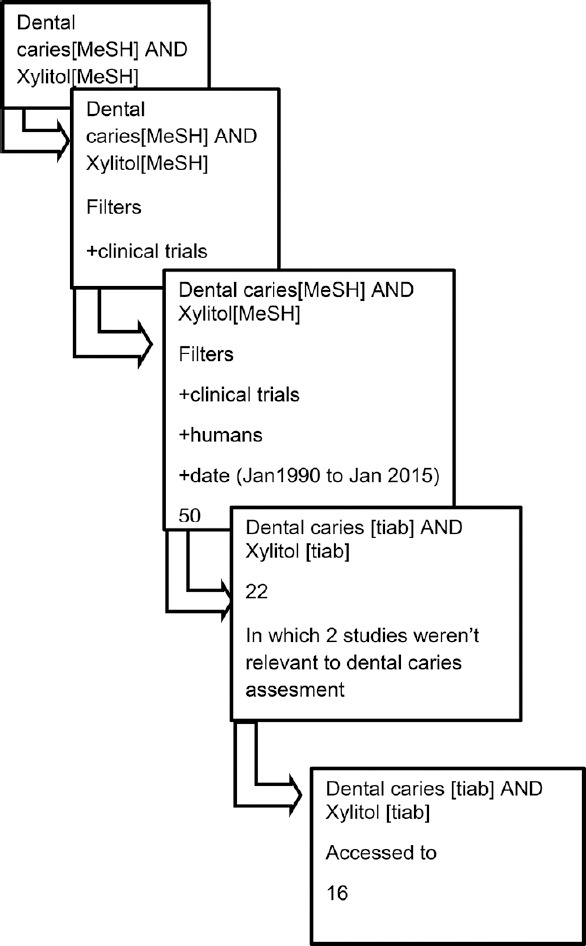
Search strategies
Study selection and eligibility criteria
This review is confined to randomized control trial (RCT) published and indexed in database (PubMed), assessing the role of xylitol in dental caries within the period of 1990–2014 (June). The included studies follow the below-mentioned criteria:
Human experiments
Study participants included both children and adults
Trials done on participants using orthodontic appliances
Xylitol dispensed in any form or mode, for example, gum, candy, etc.
Studies which compare the effect of xylitol on dental caries and on any other phenotype that will determine the preventive effect on dental caries such as DMF/DMFS/dmf/dmfs and salivary or plaque MS level.
Two reviewers (DK and CJ) independently identified potential references and eliminated ineligible studies.
Data extraction and management
The methodological quality of clinical trials was assessed by the reviewer (DK) using structured tables (JDADE and risk of bias). Discrepancies were sought out with the help of second researcher (CJ). The data extraction protocol consisted of the following information:
Bibliographic details of the study
Baseline characteristics of the participants in the study including age, number of participants in the study, and gender. Furthermore, specific group such as school students or orthodontic patients were noted, and where mentioned
Inclusion criteria
Interventional characteristics such as type or mode of xylitol delivery, etc.
Additional information on apriori calculation of sample size, duration of the study, power calculation, adequate follow-up, etc.
Other information concerning ethical approval and informed consent.
The risk of bias tool evaluates six specific domains:
Sequence generation (selection bias)
Allocation concealment (selection bias)
Blinding of outcome assessment (detection bias)
Incomplete outcome data (attrition bias)
Selective outcome reporting (reporting bias)
Other sources of bias; comparability of groups at baseline.
Assessment of reporting bias
We assessed heterogeneity by inspection of a graphical display of the estimated intervention effects from the trials along with their 95% confidence interval (95% CI) and by Cochran's test for heterogeneity undertaken before each meta-analysis as described in the Cochrane handbook for systematic Reviews of interventions.
Data synthesis
The basis for meta-analysis was from the published standard mean (SM) for the intervention corresponding to 95% CI. Statistical values such as SM difference (SMD) have no inherent clinical meaning, so SM was used to compile the data for the synthesis and analyzing. Heterogeneity of study specific effects was assessed using I2 statistics based on Review Manager (RevMan) Version 5.2. Copenhagen: The Nordic Cochrane Centre, The Cochrane Collaboration, 2012. Publication bias was also assessed using funnel plots for both main analysis and subgroup analysis.
Subgroup analyses included were the effect of other preventive strategies such as fluoride varnish on the reduction in MS count level. Studies which had missing data were excluded. Additional subgroup analyses were undertaken to explore heterogeneity. Evidence of variability in any subgroup was further explored by examining funnel plots. Sensitivity analyses were not conducted since there were very few studies.
Presentation of data
A “summary of findings” table was developed for the primary outcomes of this review. It provides information concerning the overall quality of the evidence from the trials, the magnitude of the effect of the interventions examined, and the sum of available data on the primary and secondary outcomes.
RESULTS
The search strategies included 22 trials initially until January 2015, out of which two studies were excluded after critical evaluation of the title and abstract since it was not relevant for the assessment of dental caries over the intervention as shown in Figure 2. Full-text articles were then searched in electronic and library search out of which only 16 full-text trials were accessed. Later, the trials were thoroughly read through, and risk of bias assessment was carried out. The studies with low risk (three trials) and moderate risk (nine trials) of bias were then selected for this review.
Figure 2.
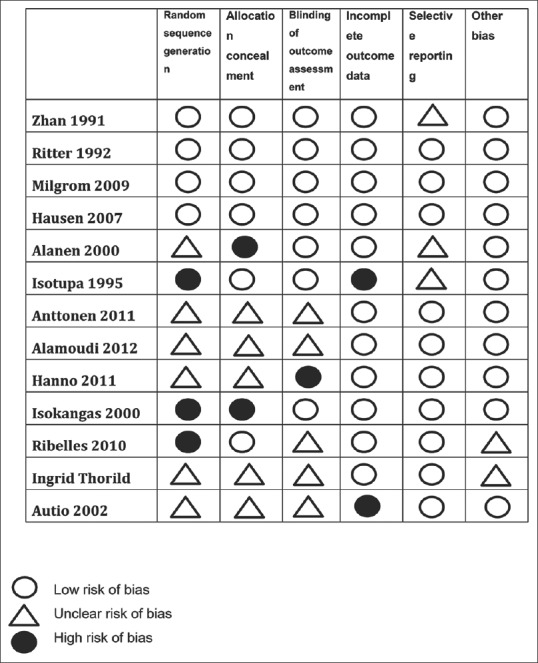
Risk of bias in included studies
Included studies for analysis
Zhan et al., 2012;[10] Ritter et al. 2013;[11] Milgrom et al. 2009;[12] Hausen et al. 2007;[13] Alanen et al. 2000;[14] Isotupa et al. 1995;[15] Anttonen et al. 2012;[16] Alamoudi et al. 2012;[17] Hanno et al. 2011;[18] Isokangas et al. 2000;[19] Ribelles Llop et al. 2010;[20] Thorild et al 2003;[21] Autio 2002.[22]
Characteristics of included studies
Intervention dispensed as lozenges, candies, gums, candies, syrup, and wipes were included in the study. The effect of intervention dispensed in gums was found to be majorly used in the selected studies. Seven trials (1478 participants the end of the study) in the outcome of dental caries reduction (DMFS/dmfs) provided data for analysis. Three trials (198 participants at the end of the study) provided data for analysis on MS count reduction. Remaining four trials were not included in the analysis since the data were in SMD, which had no inherent clinical meaning.
Risk of bias in included studies
The generation of randomization sequence and concealment of allocation was at low risk of bias for seven trials, high risk of bias for nine trials. The outcome assessment was at high risk of bias in five trials, and low risk of bias in 11 trials out of which nine trials were carried out with double blinding. All trials except for two trials (high risk) were at low risk of bias in reporting the outcome data completely.
Effects of intervention
Xylitol versus all controls (comparison 1)
The meta-analysis of seven trials where DMFS/dmfs index was used, and SM of − 1.09 (95% CI, −1.34, −0.83) showing average (unclear risk of bias) levels of heterogeneity (I2 = 69%). Which shows that the meta-analysis of seven articles was found to be significant (P < 0.00001) and supports in favor of xylitol with moderate levels of heterogeneity as shown in Figure 3.
Figure 3.
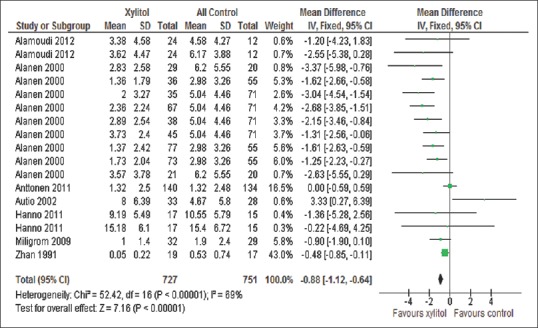
Forest plot comparing xylitol versus all controls with decayed, missing, and filled as outcome
Xylitol versus placebo (comparison 2)
The meta-analysis of three trials where DMFS/dmfs index was used, and SM of −0.88 (95% CI, −1.12, −0.64) showing average levels of heterogeneity (I2 = 67%). which shows that the meta-analysis of the three studies comparing xylitol with placebo controls was found to be significant (P < 0.0005) supporting xylitol over the placebo with average levels of heterogeneity among trials.
Xylitol versus fluoride varnish (comparison 3)
The meta-analysis of three trials where DMFS/dmfs index was used, and SM of −1.87 (95% CI, −2.89, −0.84) showing low levels of heterogeneity (I2 = 0%). Which shows that the meta-analysis of the three trials comparing xylitol with that of fluoride varnish was found to be insignificant (P = 0.090), supporting xylitol over the fluoride varnish with no major heterogeneity as shown in Figure 4.
Figure 4.
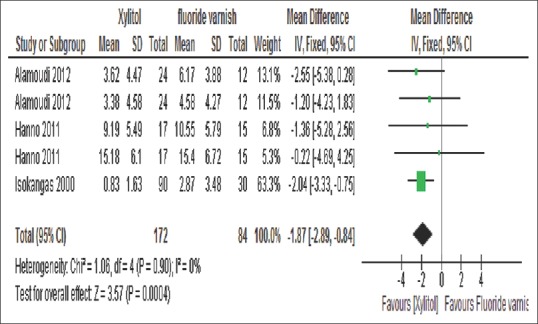
Forest plot comparing xylitol versus fluoride varnish with decayed, missing, and filled as outcome
Subgroup analysis
Xylitol versus all controls (comparison 4)
The meta-analysis of three trials where MS counts was used as outcome measure, and SM of 0.30 (95% CI, 0.05, 0.56) showing low levels of heterogeneity (I2 = 40%). Which supports in favor of all other controls which is insignificant (P = 0.14) with low levels of heterogeneity among trials as shown in Figure 5.
Figure 5.
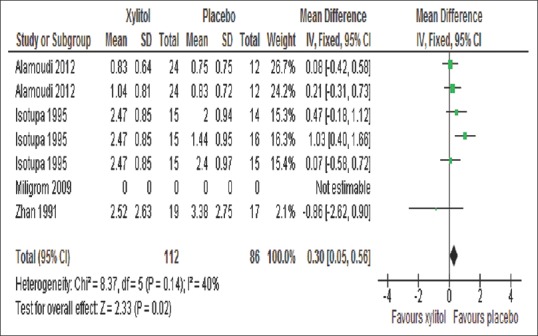
Forest plot comparing xylitol versus placebo with mutans streptococci count as outcome
Xylitol in combination with other polyols (comparison 5)
The meta-analysis of one of the trials where MS counts were used as outcome measure, and SM of −0.11 (95% CI, −0.23, 0.01) showing low levels of heterogeneity (I2 = 8%). Which supports the xylitol over the other polyols which was found to be insignificant (P = 0.35) with negligible levels of heterogeneity.
DISCUSSION
In 1967, the National Institute of Dental Research's National Dental Advisory Council (US) identified three main areas of emphasis to inform priorities to eradicate caries: Reducing the virulence of bacteria once exposed to sugars, fluoride delivery, and of most concern to the sugar industry and dietary modification.[23] Similarly, xylitol has been in debate as a caries preventive strategy, and research has been carried for the past three decades. There is overwhelming evidence that sugar in the diet is the prime culprit in causing dental caries.[24] Replacement of sugar with xylitol may be an effective strategy in preventing dental caries, but the results of this review do not indicate that prevention is worthwhile only with xylitol.
The review was carried out with the help of two outcome measures, DMFS/dmfs index (main analysis) and MS count (subgroup analysis). In the main analysis, xylitol was compared with all the controls separately, compared with placebo and with fluoride varnish. All the main analysis supports the xylitol group. However, in the group analysis, comparing the effects with all controls, heterogeneity was found to higher among all the analysis, which might be since the study showing the effect of xylitol had the unclear risk of bias. Similarly, the comparison of xylitol with placebo gives evidence supporting xylitol; however, it demonstrated a higher risk of bias as opposed to other studies used for the analysis. The comparison of xylitol with that of fluoride varnish was found to have higher levels of heterogeneity, but the three studies included was found to have unclear risk of bias among the studies included in the main group analysis.
The subgroup analysis comparing the effect of xylitol with that of other polyols was found to be supporting xylitol, which had a less heterogeneity since only one study was included and seen to have a low risk of bias.
The effective vehicle or mode of delivering xylitol was observed to be chewing gums though other forms might be equally good; however, it is observed that high sucrose intake at 3 years of age increases the risk of increased MS count and with increased caries rate from 3 to 16 years. It is evident that majority of children reported for their first dental visit in India was between 6 and 12 years (59.08%).[25] Expert advice on oral care and professionally applied caries preventive efforts are inaccessible to the individual. However, per capita consumption for an average Indian is 20.2 kg.
In the last 50 years, sugar consumption in India has gone up from 5% to 13% of sugar produced globally.[26] Consumption of high sugar may lead to high risk for children to develop dental caries. However, the prevalence of caries is also observed even in developed countries. Hence, effective strategies and mode of delivery may be planned to control MS colonies targeting this age group, might be by replacing sucrose in diet or OTC product with that of xylitol-based agents in preventing dental caries through community-based approach.
This systematic review was found to be supporting in favors of xylitol when compared with other caries preventive strategies. Xylitol was found to be an effective strategy as self-applied caries preventive agent or as OTC sweetener; however, the included studies in the meta-analysis were found to have unclear risk of bias. Further, RCTs with low risk of bias are required for strong evidence-based systematic review.
CONCLUSION
Trials that assess efficacy of xylitol under ideal conditions would be conducive to further RCTs to examine its clinical effectiveness. This review has demonstrated the need for high-quality RCTs in this area. Further trials should be well-designed RCTs and reported according to the Consolidated Standards of Reporting Trials statement or Risk of Bias Assessment Tool. In particular, appropriate control groups should be used, and trials should be designed with adequate power in view of a potential high drop-out rate (>40%) with a follow-up period of at least 3 years.
It is suggestive that additional studies should be performed to determine:
The age at which it is best to start consuming xylitol
The frequency of consumption
Effective mode of delivering xylitol
The optimum concentration of fluoride to be added.
Financial support and sponsorship
Nil.
Conflicts of interest
There are no conflicts of interest.
REFERENCES
- 1.Petersen PE. The World Oral Health Report 2003: Continuous improvement of oral health in the 21st century – The approach of the WHO Global Oral Health Programme. Community Dent Oral Epidemiol. 2003;31(Suppl 1):3–23. doi: 10.1046/j..2003.com122.x. [DOI] [PubMed] [Google Scholar]
- 2.Alaluusua S, Renkonen OV. Streptococcus mutans establishment and dental caries experience in children from 2 to 4 years old. Eur J Oral Sci. 1983;91:453–7. doi: 10.1111/j.1600-0722.1983.tb00845.x. [DOI] [PubMed] [Google Scholar]
- 3.Cheon K, Moser SA, Wiener HW, Whiddon J, Momeni SS, Ruby JD, et al. Characteristics of Streptococcus mutans genotypes and dental caries in children. Eur J Oral Sci. 2013;121(3 Pt 1):148–55. doi: 10.1111/eos.12044. [DOI] [PMC free article] [PubMed] [Google Scholar]
- 4.Hamada S, Slade HD. Biology, immunology, and cariogenicity of Streptococcus mutans. Microbiol Rev. 1980;44:331–84. doi: 10.1128/mr.44.2.331-384.1980. [DOI] [PMC free article] [PubMed] [Google Scholar]
- 5.Hanson J, Campbell L. Xylitol and caries prevention. J Mass Dent Soc. 2011;60:18–21. [PubMed] [Google Scholar]
- 6.Mühlemann HR, Regolati B, Marthaler TM. The effect on rat fissure caries of xylitol and sorbitol. Helv Odontol Acta. 1970;14:48–50. [PubMed] [Google Scholar]
- 7.Trahan L, Mouton C. Selection for Streptococcus mutans with an altered xylitol transport capacity in chronic xylitol consumers. J Dent Res. 1987;66:982–8. doi: 10.1177/00220345870660052301. [DOI] [PubMed] [Google Scholar]
- 8.Scheinin A, Mäkinen KK, Tammisalo E, Rekola M. Turku sugar studies XVIII. Incidence of dental caries in relation to 1-year consumption of xylitol chewing gum. Acta Odontol Scand. 1975;33:269–78. doi: 10.3109/00016357509004632. [DOI] [PubMed] [Google Scholar]
- 9.American Academy on Pediatric Dentistry Council on Clinical Affairs. Policy on the use of xylitol in caries prevention. Pediatr Dent 2008. 2009;30(7 Suppl):36–7. [PubMed] [Google Scholar]
- 10.Zhan L, Cheng J, Chang P, Ngo M, Denbesten PK, Hoover CI, et al. Effects of xylitol wipes on cariogenic bacteria and caries in young children. J Dent Res. 2012;91(7 Suppl):85S–90S. doi: 10.1177/0022034511434354. [DOI] [PMC free article] [PubMed] [Google Scholar]
- 11.Ritter AV, Bader JD, Leo MC, Preisser JS, Shugars DA, Vollmer WM, et al. Tooth-surface-specific effects of xylitol: Randomized trial results. J Dent Res. 2013;92:512–7. doi: 10.1177/0022034513487211. [DOI] [PMC free article] [PubMed] [Google Scholar]
- 12.Milgrom P, Ly KA, Tut OK, Mancl L, Roberts MC, Briand K, et al. Xylitol pediatric topical oral syrup to prevent dental caries: A double-blind randomized clinical trial of efficacy. Arch Pediatr Adolesc Med. 2009;163:601–7. doi: 10.1001/archpediatrics.2009.77. [DOI] [PMC free article] [PubMed] [Google Scholar]
- 13.Hausen H, Seppa L, Poutanen R, Niinimaa A, Lahti S, Kärkkäinen S, et al. Noninvasive control of dental caries in children with active initial lesions. A randomized clinical trial. Caries Res. 2007;41:384–91. doi: 10.1159/000104797. [DOI] [PubMed] [Google Scholar]
- 14.Alanen P, Isokangas P, Gutmann K. Xylitol candies in caries prevention: Results of a field study in Estonian children. Community Dent Oral Epidemiol. 2000;28:218–24. doi: 10.1034/j.1600-0528.2000.280308.x. [DOI] [PubMed] [Google Scholar]
- 15.Isotupa KP, Gunn S, Chen CY, Lopatin D, Mäkinen KK. Effect of polyol gums on dental plaque in orthodontic patients. Am J Orthod Dentofacial Orthop. 1995;107:497–504. doi: 10.1016/s0889-5406(95)70117-6. [DOI] [PubMed] [Google Scholar]
- 16.Anttonen V, Halunen I, Päkkilä J, Larmas M, Tjäderhane L. A practice-based study on the effect of a short sucrose/xylitol exposure on survival of primary teeth caries free. Int J Paediatr Dent. 2012;22:356–62. doi: 10.1111/j.1365-263X.2011.01205.x. [DOI] [PubMed] [Google Scholar]
- 17.Alamoudi NM, Hanno AG, Sabbagh HJ, Masoud MI, Almushayt AS, El Derwi DA. Impact of maternal xylitol consumption on mutans streptococci, plaque and caries levels in children. J Clin Pediatr Dent. 2012;37:163–6. doi: 10.17796/jcpd.37.2.261782tq73k4414x. [DOI] [PubMed] [Google Scholar]
- 18.Hanno AG, Alamoudi NM, Almushayt AS, Masoud MI, Sabbagh HJ, Farsi NM. Effect of xylitol on dental caries and salivary Streptococcus mutans levels among a group of mother-child pairs. J Clin Pediatr Dent. 2011;36:25–30. doi: 10.17796/jcpd.36.1.d4g77616714w3372. [DOI] [PubMed] [Google Scholar]
- 19.Isokangas P, Söderling E, Pienihäkkinen K, Alanen P. Occurrence of dental decay in children after maternal consumption of xylitol chewing gum, a follow-up from 0 to 5 years of age. J Dent Res. 2000;79:1885–9. doi: 10.1177/00220345000790111201. [DOI] [PubMed] [Google Scholar]
- 20.Ribelles Llop M, Guinot Jimeno F, Mayné Acién R, Bellet Dalmau LJ. Effects of xylitol chewing gum on salivary flow rate, pH, buffering capacity and presence of Streptococcus mutans in saliva. Eur J Paediatr Dent. 2010;11:9–14. [PubMed] [Google Scholar]
- 21.Thorild I, Lindau B, Twetman S. Effect of maternal use of chewing gums containing xylitol, chlorhexidine or fluoride on mutans streptococci colonization in the mothers’ infant children. Oral Health Prev Dent. 2003;1:53–7. [PubMed] [Google Scholar]
- 22.Autio JT. Effect of xylitol chewing gum on salivary Streptococcus mutans in preschool children. ASDC J Dent Child. 2002;69:81–6, 13. [PubMed] [Google Scholar]
- 23.Kearns CE, Glantz SA, Schmidt LA. Sugar industry influence on the scientific agenda of the National Institute of Dental Research's 1971 National Caries Program: A historical analysis of internal documents. PLoS Med. 2015;12:e1001798. doi: 10.1371/journal.pmed.1001798. [DOI] [PMC free article] [PubMed] [Google Scholar]
- 24.Gupta P, Gupta N, Pawar AP, Birajdar SS, Natt AS, Singh HP. Role of sugar and sugar substitutes in dental caries: A review. ISRN Dent. 2013;2013:519421. doi: 10.1155/2013/519421. [DOI] [PMC free article] [PubMed] [Google Scholar]
- 25.Meera R, Muthu MS, Phanibabu M, Rathnaprabhu V. First dental visit of a child. J Indian Soc Pedod Prev Dent. 2008;26(Suppl 2):S68–71. [PubMed] [Google Scholar]
- 26.Desai Teja Lele. Lakhs of Indians Becoming Sugar Dependent. Times India. 2013. [Last cited on 2015 Oct 08]. Available from: http://www.timesofindia.indiatimes.com/life-style/health-fitness/diet/Lakhs-of-Indians-becoming-sugar-dependent/articleshow/19456525.cms .


